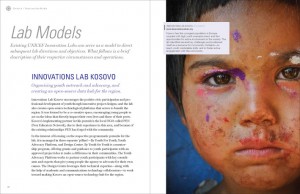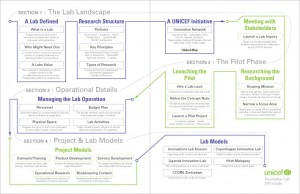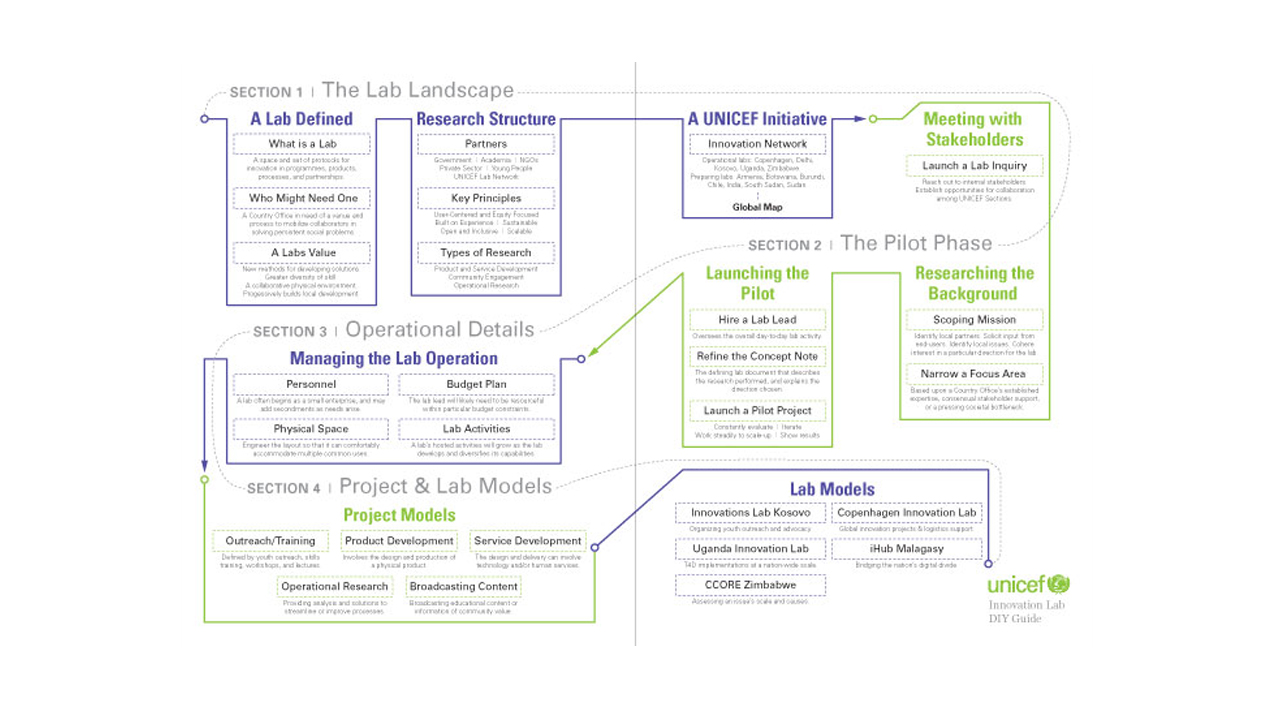Art Center MDP Alumnus Dustin York Continues His Work with the UNICEF Innovation Team
Dustin York is a 2012 graduate from the Art Center College of Design with an MFA in Media Design. In 2010, he was a Designmatters Graduate Design Fellow, where he worked on UNICEF’s Child Friendly Technology, a framework for adapting and deploying technology into developing regions’ primary school curriculums. In 2011, he worked with the MIT Senseable City Lab on the LIVE Singapore! project, where he designed and visualized speculative futures revolving around the real-time networked urban environment. Recently, Dustin started working as an interaction designer for Social Finance, Inc., a San Francisco-based start-up that provides an alternative to the traditional student loan by connecting alumni investors with student borrowers.
For much of this preceding year I had the pleasure to work on helping to solidify and spread the vision regarding UNICEF Innovation labs. The project I am referencing is called the Innovation Lab Do-It-Yourself Guide. The DIY Guide was initiated and informed by the experts and innovation leaders within the UNICEF organization — including Innovation Unit co-leader Christopher Fabian and lab leaders in Kosovo, Uganda, and Copenhagen. We also benefited greatly from input by UNICEF specialists in Madagascar, Botswana, Finland, and New York.
Both myself and project collaborator Dee Kim had worked with New York-based UNICEF Innovation Unit before, as Designmatters Fellows in 2010 and 2011 respectively; our task on this project was essentially a further extension of our prior fellowship experience. My value as a consultant was to use my design experience to communicate UNICEF’s innovation challenges and objectives clearly, and rely on my judgement and knowledge of technology-for-development processes to create a visual framework that aids lab adopters and accelerates early lab development.
 UNICEF is in the midst of accelerating in-country innovation efforts across their far-reaching and diverse global network. The organization has made great strides in the technology-for-development field, and the next step in leveraging that hard-won expertise is to establish a robust network of innovation labs. Existing labs (in Kosovo, Uganda, Zimbabwe, Copenhagen, Sudan, and Delhi) are already becoming regional locus points that spread ideas and create products through open source technology, new modes of collaborative partnership, and the simple yet necessary process of learning-by-doing. New labs are being created every month — there are at least six currently in the pilot stage — they will learn from the steps already taken by more experienced labs, and create their own innovation footprint that serves the particular needs and specialties of their locality.
UNICEF is in the midst of accelerating in-country innovation efforts across their far-reaching and diverse global network. The organization has made great strides in the technology-for-development field, and the next step in leveraging that hard-won expertise is to establish a robust network of innovation labs. Existing labs (in Kosovo, Uganda, Zimbabwe, Copenhagen, Sudan, and Delhi) are already becoming regional locus points that spread ideas and create products through open source technology, new modes of collaborative partnership, and the simple yet necessary process of learning-by-doing. New labs are being created every month — there are at least six currently in the pilot stage — they will learn from the steps already taken by more experienced labs, and create their own innovation footprint that serves the particular needs and specialties of their locality.
 The guide was primarily created to give new labs the information and tools they need at the outset, and beyond that, to shape an innovation identity and sharing mechanism for explicating efforts that are all being honed in uniquely specific circumstances. The physical products our team created was a comprehensive Do-It-Yourself Innovation Lab Guide, an online instructional system that can grow alongside UNICEF’s innovation efforts, a series of actionable worksheets that facilitates a managerial framework for new lab management, and a document annex representing concrete examples created by existing UNICEF innovation labs. It was a curated and thoroughly constructed communication system that wouldn’t have been possible without the steady input and applied knowledge paved by dedicated UNICEF staff, volunteers, engaged youth, and government and private sector partners.
The guide was primarily created to give new labs the information and tools they need at the outset, and beyond that, to shape an innovation identity and sharing mechanism for explicating efforts that are all being honed in uniquely specific circumstances. The physical products our team created was a comprehensive Do-It-Yourself Innovation Lab Guide, an online instructional system that can grow alongside UNICEF’s innovation efforts, a series of actionable worksheets that facilitates a managerial framework for new lab management, and a document annex representing concrete examples created by existing UNICEF innovation labs. It was a curated and thoroughly constructed communication system that wouldn’t have been possible without the steady input and applied knowledge paved by dedicated UNICEF staff, volunteers, engaged youth, and government and private sector partners.
Creating this DIY Guide required the need for constant evaluation of process. Going into this project, I wrongly anticipated that communicating what a UNICEF innovation lab is and what it involves to start one would be a fairly discrete and clear-cut mission. I quickly learned that what each lab sets out to be and to accomplish is largely dictated by the specific needs and capacities of the local lab; we needed to create a guide that provides freedom for declaring an individual vision regarding what the lab will set out to accomplish, and at what scale and timeline. Country offices should not be compelled to adapt a rigid model to them, rather their innovation efforts should benefit from their knowledge of the region, the relationships they have forged, and the benefit to UNICEF network is that it learns from their contributions. Every documented success is an opportunity to be deployed elsewhere, and also every setback is something every other lab can be sure to avoid.
 This philosophical underpinning led our focus to creating a guide that is not prescriptive but empowering. We provide examples without dictating the need for strict adoption, and the guide is clear not to provide minimum size, staff, or budgetary guidelines. This is because our purpose is not to exclude, complicate, or disincentivize the adoption of a valuable and still developing working method in innovation and research. What we wanted to create is a tool that makes information more accessible and helps innovation leaders make better decisions. We have recently completed Version 1 of the Innovation Lab Do-It-Yourself Guide; the project will keep growing with the network, because the work of innovation is never finished. That is the part of the work I am most excited about, and happy to be a part of. I look forward to seeing where UNICEF Innovation goes from here!
This philosophical underpinning led our focus to creating a guide that is not prescriptive but empowering. We provide examples without dictating the need for strict adoption, and the guide is clear not to provide minimum size, staff, or budgetary guidelines. This is because our purpose is not to exclude, complicate, or disincentivize the adoption of a valuable and still developing working method in innovation and research. What we wanted to create is a tool that makes information more accessible and helps innovation leaders make better decisions. We have recently completed Version 1 of the Innovation Lab Do-It-Yourself Guide; the project will keep growing with the network, because the work of innovation is never finished. That is the part of the work I am most excited about, and happy to be a part of. I look forward to seeing where UNICEF Innovation goes from here!
For more information about UNICEF, visit: www.unicef.org/
